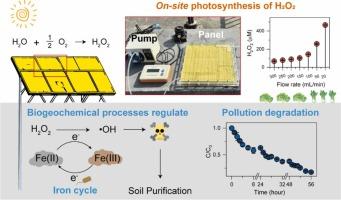通过内源铁循环和羟基自由基生成调控加速污染土壤的自然净化
IF 11.3
1区 环境科学与生态学
Q1 ENGINEERING, ENVIRONMENTAL
引用次数: 0
摘要
土壤污染与有机化学品是一个重大的全球环境挑战。最近,监测的自然净化虽然环保,但修复速度缓慢。在这里,我们报告了一种创新的方法,通过调节内源性铁循环和羟基自由基(•OH)的产生来加速土壤的自然净化,同时保持土壤的功能。通过定期添加轻度浓度的H2O2来激活土壤中的铁矿物,我们触发了内源性芬顿样反应,导致•OH生成显著增加10.4倍。同时,氧化铁通过微生物还原再生,完成铁的生物地球化学氧化还原循环。经过5个循环后,污染物去除率提高了6.3倍,苯酚降解率达到95%。与化学修复相比,该方法减少了91%的有机物损失,保持了96%的微生物活性。此外,处理过的土壤保持了肥力,支持生菜和卷心菜的旺盛生长。为了进一步改进该系统,我们开发了一种现场H2O2生产系统,该系统仅由阳光、水和空气提供动力,无需额外的能源或化学投入。这个综合系统显示了加速和可持续土壤修复的潜力。我们的研究结果强调了加速自然净化作为解决土壤污染同时保护环境健康和农业生产力的变革性方法的前景。本文章由计算机程序翻译,如有差异,请以英文原文为准。

Accelerating natural purification of contaminated soils through endogenous iron cycle and hydroxyl radical production regulation
Soil contamination with organic chemicals is a critical global environmental challenge. Recently, monitored natural purification, though eco-friendly, suffers from slow remediation rates. Here, we report an innovative approach through regulating endogenous iron cycle and hydroxyl radical (•OH) productions to accelerate natural soil purification while maintaining soil functionality. By periodically adding mild concentrations of H2O2 to activate soil iron minerals, we triggered an endogenous Fenton-like reaction, resulting in a significant 10.4-fold increase in •OH generation. Simultaneously, oxidized iron was regenerated through microbial reduction, completing the biogeochemical redox cycles of iron. Over five cycles of these redox processes, pollutant removal rate was enhanced by 6.3-fold, achieving >95% phenol degradation. Compared to chemical remediation, this approach reduced organic matter loss by 91% and preserved 96% microbial activity. Furthermore, treated soils maintained fertility, supporting vigorous lettuce and cabbage growth. To further advance this system, we developed an on-site H2O2 production system powered solely by sunlight, water, and air, eliminating the need for additional energy or chemical inputs. This integrated system demonstrates the potential for accelerated and sustainable soil remediation. Our findings highlight the promise of accelerated natural purification as a transformative approach to address soil contamination while safeguarding environmental health and agricultural productivity.
求助全文
通过发布文献求助,成功后即可免费获取论文全文。
去求助
来源期刊

Journal of Hazardous Materials
工程技术-工程:环境
CiteScore
25.40
自引率
5.90%
发文量
3059
审稿时长
58 days
期刊介绍:
The Journal of Hazardous Materials serves as a global platform for promoting cutting-edge research in the field of Environmental Science and Engineering. Our publication features a wide range of articles, including full-length research papers, review articles, and perspectives, with the aim of enhancing our understanding of the dangers and risks associated with various materials concerning public health and the environment. It is important to note that the term "environmental contaminants" refers specifically to substances that pose hazardous effects through contamination, while excluding those that do not have such impacts on the environment or human health. Moreover, we emphasize the distinction between wastes and hazardous materials in order to provide further clarity on the scope of the journal. We have a keen interest in exploring specific compounds and microbial agents that have adverse effects on the environment.
 求助内容:
求助内容: 应助结果提醒方式:
应助结果提醒方式:


